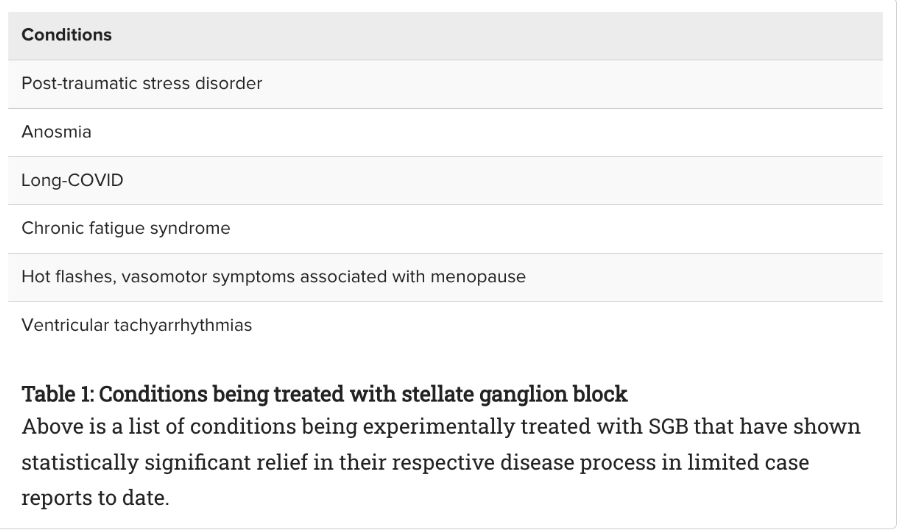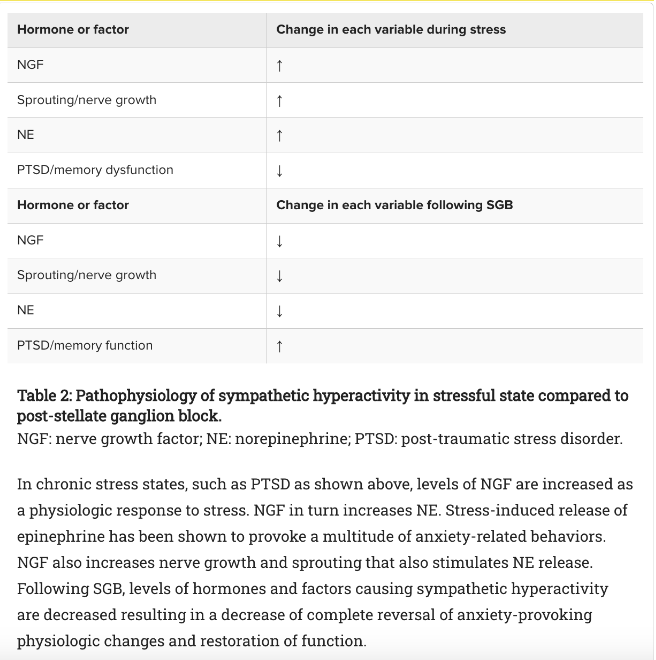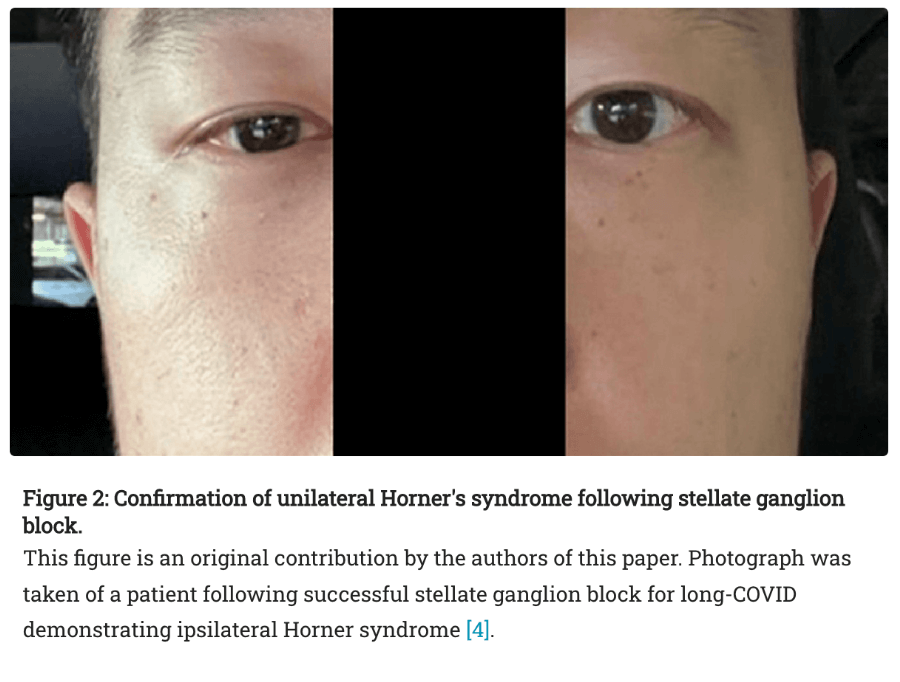A peer review of the Stellate Ganglion Block spotlights its effectiveness

Stellate Ganglion Block (SGB) helped with multiple challenges
A team of medical researchers at Baylor University conducted a review of Stellate Ganglion Block that concluded Stellate Ganglion Block (SGB) had shown efficacy for addressing a variety of challenges and may even help with cases that do not respond to other treatments.

Studies like this advance the field of practice, providing detailed information about an individual or group's treatment and outcomes. They play an important role in:
-
Advancing medical knowledge.
-
Improving care.
-
Expanding our understanding of the natural history of a disease, its biological and physiological effects, and treatment options.
-
Furthering research to develop and refine clinical guidelines and best practices.
Since 2020, Stella's advanced Stellate Ganglion Block (SGB) protocol, the Dual Sympathetic Reset (DSR), has been used to treat symptoms of trauma, anxiety, and depression in over 5,000 individuals. The Dual Sympathetic Reset features two injections of local anesthetic on the same side of the neck next to a bundle of fight-or-flight nerves to help restore a sense of calm in the body and mind. It has the potential to relieve even the most severe symptoms of trauma. This can help reset the fight-or-flight response to its pre-trauma state. In recent months, the Stellate Ganglion Block (SGB) has also shown promising results when treating Long-COVID.
Not only does the study published by Cureus bring attention to SGB's effect on Long-COVID and PTSD, but it highlights its effectiveness on other challenges as well.
This comprehensive review of Stellate Ganglion Block (SGB) fuses together all "non-pain indications" into one piece of research and can help the reader (patient, doctor, referee etc) better understand how Stellate Ganglion Block (SGB) can impact seemingly unrelated conditions.
Michael Gershenzon, Co-Founder and CFO of Stella
Stellate Ganglion Block (SGB) for Post-traumatic stress disorder (PTSD)
PTSD is a mental health condition that can occur after traumatic events or experiencing ongoing stressors. Symptoms can include intrusive memories or flashbacks, avoiding reminders of the event, negative changes in mood and thinking, and the feeling of being on edge or easily startled. Conventional treatments for PTSD involve therapy and medication, but this approach doesn't work for many who suffer. Stellate Ganglion Block (SGB) has shown promise in helping people with PTSD by reducing symptoms like anxiety and hyperarousal.
Stella has seen positive outcomes among most patients and increased acceptability when trauma is viewed as an injury. Dropping the "D" in PTSD highlights the possibility that trauma's impact may be best characterized as an injury rather than a disorder.
There are two key reasons why dropping "Disorder" is essential:
-
"Disorder" connotes a sense of permanence which is misleading because post traumatic stress is treatable.
-
"Disorder" has a stigma that can prevent those who need help from asking for it.
The language we use to describe human experiences matters. Words have the power to make us feel isolated and stuck or understood and empowered. The terms used in the medical and mental health fields must evolve as we continually evolve our understanding of human challenges. Advances in scanning technology have confirmed that trauma exposure alters our biological functioning. Specifically, changes in brain physiology that are associated with the impact of post-traumatic stress can be visualized on a brain scan. In fact, NYU Langone Health is currently conducting a landmark study of the DSR-SGB that involves pre and post-procedure fMRI scans.
The study aims to demonstrate that the DSR-SGB can help heal the damage caused by trauma exposure and that this healing effect will be visible on post-procedure scans. This neuroscience-informed understanding warrants a change in our terminology - from seeing trauma as solely a "mental health disorder" to viewing trauma as an injury that can be healed through a combination of biological and psychological treatments. Updating our language to match advances in the field of care helps destigmatize the term and encourages others to seek solutions to the challenges they are experiencing. We encourage you to adopt the term Post-Traumatic Stress Injury (PTSI), too.

Stellate Ganglion Block (SGB) for Anosmia
Anosmia is a condition where a person experiences a partial or complete loss of smell, which can be caused by various factors, including chronic sinonasal disease, head trauma, COVID-19, and neurodegenerative disease. Current treatment options for anosmia are limited, but Stellate Ganglion Block (SGB) has shown promise. It is thought to enhance blood flow and lead to long-lasting relief of symptoms. Addressing and resolving anosmia restores the ability to taste food.
Stellate Ganglion Block (SGB) for Long COVID and Chronic Fatigue Syndrome
This review's exploration of the Stellate Ganglion Block (SGB) treatment for Long COVID can provide further support for Stella's adapted Stellate Ganglion Block (SGB) protocol, DSR, to address a variety of sympathetically driven concerns.
Chronic Fatigue Syndrome (CFS) is characterized by severe fatigue lasting longer than six months and may be associated with other symptoms, such as:
-
Extreme fatigue that is not relieved by rest or sleep
-
Muscle and joint pain
-
Brain fog, difficulty with memory and concentration
-
Headaches
-
Sore throat
-
Tender lymph nodes
-
Unrefreshing sleep
-
Digestive issues, such as irritable bowel syndrome (IBS)
-
Sensitivity to light, sound, and other stimuli
-
Dizziness
Long COVID shares similar symptoms with CFS. Both causes need to be better understood; however, this case report suggests that Stellate Ganglion Block (SGB) may potentially relieve Long COVID fatigue.
Stellate Ganglion Block (SGB) Hot flashes and Vasomotor Symptoms
Hot flashes, or vasomotor symptoms (VMS), are common symptoms experienced by over 75% of menopausal women. Hot flashes are characterized by flushing, sweating, and intense heat due to decreased estrogen levels, but the exact cause is not fully understood. The Stellate Ganglion Block (SGB) is a promising alternative treatment that has been shown to reduce the severity and frequency of hot flashes in some patients.
Stellate Ganglion Block (SGB) and Horner's Syndrome
After the application of Stellate Ganglion Block (SGB), an individual should expect to see a couple of side effects. These side effects are temporary, usually lasting less than 6-8 hours, sometimes up to 24 hours. They are associated with something called "Horner's Syndrome," which lets the provider know that, in all likelihood, the injection has been placed at the correct location. These signs include a droopy bloodshot right eye, possibly a warm feeling in the right arm and right side of the face, and a stuffy nose on the right side. Again, this side effect typically resolves within a few hours to a few days after the procedure.

Stella Uses Responsible Innovation
Stellate Ganglion Block (SGB), which was historically used exclusively to treat pain conditions, now appears to have all kinds of potential benefits for a wide variety of concerns - some of which had formally been solely categorized as "mental health challenges" (which are now seen as injuries in part that can be healed). While there are many organizations that use modalities to treat multiple challenges, we remain a trusted authority in responsible innovation by leveraging safe treatments in ways that change lives, like DSR and Ketamine Infusion Therapy. We work toward a future in which no one needlessly suffers from challenges like long COVID, post-traumatic stress, and chronic fatigue.